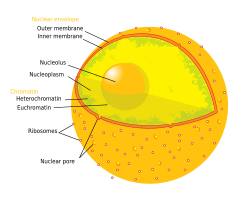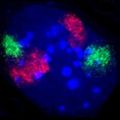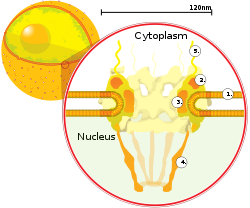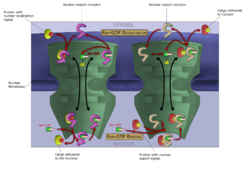Cell nucleus



The cell nucleus (plural: cell nuclei) contains the cell's genes and controls the cell's growth and reproduction. It has a double layered nuclear membrane round it. The nucleus is usually the most prominent organelle in a cell. The nucleus is small and round, and works as the cell's control center. It contains chromosomes which house the DNA. The human body contains billions of cells, most of which have a nucleus.
All eukaryote organisms have nuclei in their cells, even the many eukaryotes that are single-celled. Bacteria and Archaea, which are prokaryotes, are single-celled organisms of a different type and do not have nuclei. Cell nuclei were first found by Antonie van Leeuwenhoek in the 17th century.
The nucleus has a membrane around it but the things inside it do not. Inside it are many proteins, RNA molecules, chromosomes and the nucleolus. In the nucleolus ribosomes are put together. After being produced in the nucleolus, ribosomes are exported to the cytoplasm where they translate mRNA into proteins.
When a cell is dividing or preparing to divide, the chromosomes become visible with a light microscope. At other times when the chromosomes are not visible, the nucleolus will be visible.
Nuclear membrane
Large molecules cannot get through the double-layer nuclear membrane. However, nuclear pores exist. They control the movement of molecules across the membrane. The pores cross both nuclear membranes, providing a channel. The larger molecules are actively transported by carrier proteins, and there is free movement of small molecules and ions. Movement of large molecules such as proteins and RNA through the pores is required for both gene expression and the maintenance of chromosomes.
Nucleolus
Within the nucleus is a structure called a nucleolus. It is made at a nucleolus organizer region (NOR). This is a chromosomal region around which the nucleolus forms. Inside the nucleolus ribosomes are made. These are exported through the nuclear pore complexes to the cytoplasm. There they work to build proteins. They become attached to the endoplasmic reticulum if they are making membrane proteins.[1]
Cell Nucleus Media
HeLa cells stained for nuclear DNA with the blue fluorescent Hoechst dye. The central and rightmost cells are in interphase, thus their entire nuclei are labeled. On the left, a cell is going through mitosis and its DNA has condensed.
A mouse fibroblast nucleus in which DNA is stained blue. The distinct chromosome territories of chromosome 2 (red) and chromosome 9 (green) are stained with fluorescent in situ hybridization.
A cross section of a nuclear pore on the surface of the nuclear envelope (1). Other diagram labels show (2) the outer ring, (3) spokes, (4) basket, and (5) filaments.
An electron micrograph of a cell nucleus, showing the darkly stained nucleolus
A generic transcription factory during transcription, highlighting the possibility of transcribing more than one gene at a time. The diagram includes 8 RNA polymerases however the number can vary depending on cell type. The image also includes transcription factors and a porous, protein core.
Macromolecules, such as RNA and proteins, are actively transported across the nuclear membrane in a process called the Ran-GTP nuclear transport cycle.
An image of a newt lung cell stained with fluorescent dyes during metaphase. The mitotic spindle can be seen, stained green, attached to the two sets of chromosomes, stained light blue. All chromosomes but one are already at the metaphase plate.
References
| Wikimedia Commons has media related to Lua error in Module:Commons_link at line 62: attempt to index field 'wikibase' (a nil value).. |
- ↑ Cooper, Geoffrey M.; Hausman, Robert E. (2007). The Cell: a molecular approach (4th ed.). Sinauer Associates. pp. 371–9. ISBN 978-0878932207.








